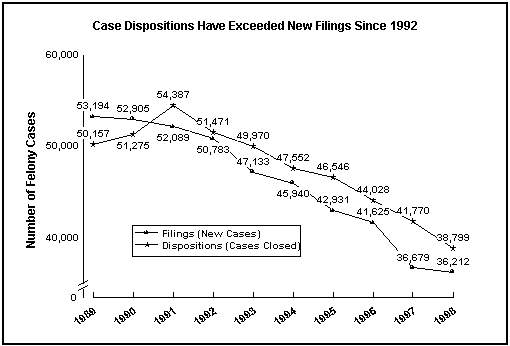Background. DOC houses three types of inmates: pre-trial detainees, inmates convicted of lesser offenses and serving sentences of up to one year, and state-sentenced inmates temporarily held in city custody (mainly parole violators and newly sentenced inmates awaiting transfer to a state prison). In fiscal year 1999, approximately two-thirds of DOC's inmate population was made up of pre-trial detainees-11,288 out of a total average jail population of 17,562.
Pre-trail detainees' cases may be disposed of through acquittal, dismissal, or conviction. If convicted, they may be sentenced to prison, probation, or time-served (with the latter meaning that the detention time already served is deemed suitable punishment). Those sentenced to prison terms of up to one year will serve out their time in city jails, while those receiving sentences of more than one year are transferred into the New York State prison system.

Pre-trial detention and city costs. Prisoners sentenced to state prison receive credit against their sentences for pre-trial detention time spent in city jails. The city absorbs nearly all such costs, about $123 per day (or $45,000 annually) for each pre-trial detainee. The state absorbs the cost of incarceration once sentenced inmates are committed into its system (as well as a portion of costs incurred by the city while state-sentenced inmates await transfer to state facilities.)
In calendar year (CY) 1998 (the most recent year for which data is available), the state prison system took custody of 12,643 inmates who had already spent an average of about 6.7 months (or 204 days) in New York City jails either in pre-trial or newly-sentenced status. Therefore, the quicker the adjudication of court cases involving those defendants detained in city jails and ultimately destined for state prison, the smaller the city's share of total incarceration costs.
Criminal cases are often not disposed of within court system's timeliness standards. The New York State Office of Court Administration's "standards and goals" calls for all felony cases to be disposed of within six months from the date of filing in Supreme Court. However, available data show that this standard is frequently not met. For example, in CY 1998 about 25 percent of felony cases adjudicated in New York City were not disposed of within six months. Moreover, the average time to disposition for felony cases has risen though the 1990s despite a steadily falling number of new cases. In the ten year period between 1989 and 1998, there was a 38 percent increase in the average number of days taken to dispose of felony cases, despite a 32 percent decrease in the court's incoming annual caseload.
Evaluating the cause of this increase is problematic, however, since some of it may be due to resolving the court's backlog of cases. In fact, dispositions (cases closed) have exceeded filings (new cases) annually since 1991. Since adjudication of longstanding cases in a given year is reflected in that year's average adjudication time, the increase in the average number of days taken to dispose of felony cases does not necessarily indicate a decrease in performance. Reducing case processing time. There are a number of system improvements that have been suggested to speed up criminal case processing in New York City without threatening public safety or compromising the integrity of the process.
New York's "discovery" process-where prosecutors and defense attorneys gain information about evidence and testimony known by the opposing side-has been criticized as being inefficient. A 1993 report by the Correctional Association of New York found that more timely discovery between the parties is needed for judges to be able to set and adhere to speedy trial dates. It has also been suggested that New York's courts need to be more effective in establishing firm timetables for all case-related activities leading to disposition. For example, a 1989 study of courts throughout the country by the National Center for State Courts recognized that "courts that take early control of their cases and insist that events take place when scheduled are likely to provide a faster pace of litigation." In response to calls for more effective case management on the part of judges, the New York Office of Court Administration developed annual performance reviews for judges. New York judges who do not meet performance standards could face demotion to lower courts.
Finally, defense counsel shortages and changes in plea bargaining practices instituted in the mid-1990s have also been cited as possible factors in the slowing of case processing. With respect to the latter, many defendants are now denied the option of pleading guilty to lesser charges once a felony indictment has been returned by a grand jury.
For more information about the NYC Department of Corrections contact Bernard O'Brien, a Senior Budget and Policy Analyst at IBO, at (212) 442-8656.